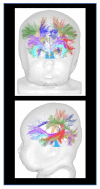Advanced Brain Imaging in Preterm Infants: A Narrative Review of Microstructural and Connectomic Disruption
- PMID: 35327728
- PMCID: PMC8947160
- DOI: 10.3390/children9030356
Advanced Brain Imaging in Preterm Infants: A Narrative Review of Microstructural and Connectomic Disruption
Abstract
Preterm birth disrupts the in utero environment, preventing the brain from fully developing, thereby causing later cognitive and behavioral disorders. Such cerebral alteration occurs beneath an anatomical scale, and is therefore undetectable by conventional imagery. Prematurity impairs the microstructure and thus the histological process responsible for the maturation, including the myelination. Cerebral MRI diffusion tensor imaging sequences, based on water's motion into the brain, allows a representation of this maturation process. Similarly, the brain's connections become disorganized. The connectome gathers structural and anatomical white matter fibers, as well as functional networks referring to remote brain regions connected one over another. Structural and functional connectivity is illustrated by tractography and functional MRI, respectively. Their organizations consist of core nodes connected by edges. This basic distribution is already established in the fetal brain. It evolves greatly over time but is compromised by prematurity. Finally, cerebral plasticity is nurtured by a lifetime experience at microstructural and macrostructural scales. A preterm birth causes a negative and early disruption, though it can be partly mitigated by positive stimuli based on developmental neonatal care.
Keywords: MRI; connectivity; microstructure; preterm infants.
Conflict of interest statement
The authors declare no conflict of interest.
Figures



References
-
- Larroque B., Ancel P.-Y., Marret S., Marchand L., André M., Arnaud C., Pierrat V., Rozé J.-C., Messer J., Thiriez G., et al. Neurodevelopmental Disabilities and Special Care of 5-Year-Old Children Born before 33 Weeks of Gestation (the EPIPAGE Study): A Longitudinal Cohort Study. Lancet. 2008;371:813–820. doi: 10.1016/S0140-6736(08)60380-3. - DOI - PubMed
-
- Stoll B.J., Hansen N.I., Bell E.F., Shankaran S., Laptook A.R., Walsh M.C., Hale E.C., Newman N.S., Schibler K., Carlo W.A., et al. Neonatal Outcomes of Extremely Preterm Infants from the NICHD Neonatal Research Network. Pediatrics. 2010;126:443–456. doi: 10.1542/peds.2009-2959. - DOI - PMC - PubMed
Publication types
LinkOut - more resources
Full Text Sources

